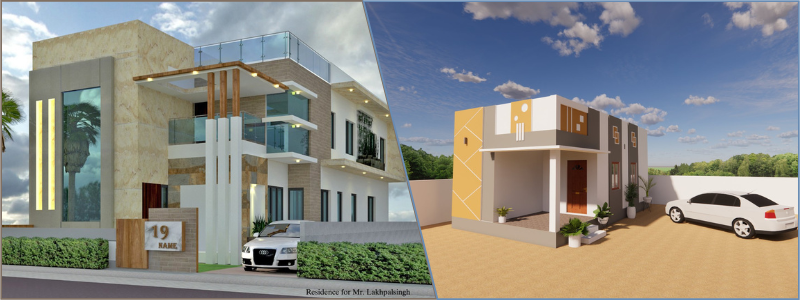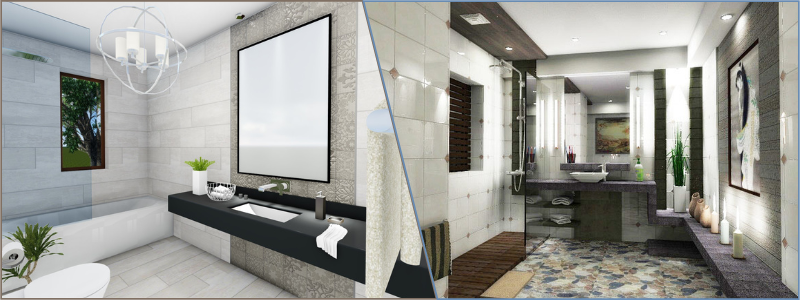How much does an architect or architectural firm cost for home design? An architect or architectural firm may charge a client on an hourly rate, fixed fee basis, percentage of construction cost, or a combination of those throughout a construction project.
Table of contents
Regardless of the payment structure, the price usually falls between 15% to 20% for remodeling and 5% to 15% for new construction. For example, if a project requires you to spend a total of $200,000, about $20,000 of the money covers the architect’s fee. Every project is unique, so that the actual cost will be based on the scope of architectural services provided, the level of architectural design requested, and the architect’s business model (a freelancer or a firm).
RELATED: Learn about architectural design fee schedules, rates, and pricing for architect firms’ costs
Factors like the architect’s reputation, pay rates of the firm’s employees, location, and overhead are also considered. As soon as the fee and payment structure are determined, the architect will break down the cost into smaller portions for a sequence of design phases. In a full architectural service, the amounts include:
- Preliminary design
- Schematic design
- Design development
- Construction document
- Bidding and negotiation
- Construction administration
The amount of money that goes into each phase is unique to every firm and depends on the period required to complete the project.
Cost for an architectural firm
Hiring an architectural firm is around $80 to $175 per hour for planning and design. Once you agree with the proposed design and the estimated cost, switching to a fixed fee or percentage of total cost method is likely more affordable than maintaining the hourly-rate structure. You know how much to spend on architectural design services right from the beginning of the construction.
RELATED: Billable rates for architect’s design services, architectural costs & hourly fees
In addition to the method mentioned earlier, an architectural firm may use the per-square-foot compensation structure. Still, it is much less common than others, especially in a remodeling project. It must be large and remodeled to make financial sense for the firm. The payment structure is not lucrative enough if the project involves only a bathroom or a kitchen. The fee ranges from $2 to $10 per square foot for new construction or addition. It is a suitable method for homeowners when they know the actual size of the project.

When you need an architect
Every homeowner wants to be the perfect handyperson who can repair, rebuild, and do all sorts of home improvement projects without hiring a professional. It is not impossible that even the most casual fixer can complete a small and large remodeling project without an architect’s help. As long as you have a clear idea of what you want, know how to get things done, and are confident in your construction skills, completing the project wouldn’t be much of a problem. However, most of such skills are obtained through years of experience and professional training instead of a trial-and-error process.
RELATED: The power of architectural CAD services
There are some projects when a DIY approach is appropriate but not in certain situations, for example:
- Bigger space in a cramped house: you need more space, but at the same time, addition is either too expensive or plain impossible due to site limitations or existing structure. An architectural firm with a team of engineers and designers will be able to determine the underlying issues with the design or room layout in the house. The team will be able to reconfigure the floor plan to take advantage of underutilized areas despite the constraints with few yet effective design alterations.
- Traffic jam in the house: a poorly designed interior can cause a traffic jam in specific locations, even if you have open spaces. You can solve the problem by repositioning the furniture pieces, de-cluttering, or removing things you no longer use. In such a case, you need an interior designer or a simple willingness to keep the objects organized. If the desired changes require significant design modification, an architect ensures it will not affect the house’s structural integrity.
- Remodeling issues you can’t solve: whether you have a problem with a remodeling plan or are aware of your limitation as a handyperson, an architect has the experience and the know-how you need. A good architect also acts as an adviser to ensure you achieve the objective and spend the right amount of money.
- You need to be on a budget: there can be many factors in a remodeling or new construction designs that might not go according to plan. One of the duties of a professional architect is to carry-out construction oversight. The apparent advantage includes the architect preventing the project from going over budget, and the architect keeps the contractor in the right direction or suggests cutting down on superficial details.
RELATED: Why hire an architectural design service?
- Building authorities require an architect: most cities do not require you to hire an architect for most remodeling projects. Hiring one is mandatory in areas (usually sub-urban) where an architect must sign the plan drawing for the remodels.
- New construction: the percentage of the estimated cost for new construction is typically lower than for remodeling. The main reason is that remodeling often involves unpredictable challenges during the project. In new construction, you start from scratch on an empty site (either unused or after the old building has been demolished). An architect can propose a complete site plan without worrying about unforeseen difficulties. Since the entire process might involve contractors’ bidding and revision, an architect takes care of everything for you.
Not every architect offers an equal quality service. You never have to hire the most expensive one or choose the most affordable option. You need an architect who shares the same design principles as yours, communicates well, and is willing to work on your budget. An experience in residential projects is a must. An architect may have to work with a contractor of your choosing or the one who comes up with the lowest bid, so it is imperative that the two can collaborate effectively to avoid any potential disputes and settle quickly in case a disagreement arises.
RELATED: Architectural plans, CAD drawing costs & architect service pricing
Cost for contractor
General contractors may charge 10% to 20% of the construction cost; the fee is often referred to as “cost-plus.” They rarely (if ever) set on an hourly rate basis. The total cost-plus already includes subcontractor labor and markup on materials in addition to a percentage of the construction cost. General contractors handle all payments on your behalf. In other words, they act as an intermediary between project owners and builders. A cost-plus typically covers the following expenses:
- Workers’ compensation
- Liability insurance
- Overhead for their employees, office space, and day-to-day operations
- Taxes
On top of those, they still have to earn a healthy profit from the services provided. General contractors take over the leading position in a project and oversee the entire scope of the process. If you hire an architect for the plan drawing services only, the architect’s involvement ends as soon as the drawings are complete and you obtain your approval. Homeowners hire a general contractor if the project involves building permits application, heavy-duty equipment, and subcontractors.
RELATED: CAD freelancers & contractors on Cad Crowd: A personalized outsourcing solution
General contractors have similar functions to those of an architect, such as:
- Determine project milestones, schedule, and timeline
- Hire competent subcontractors for different aspects of the building, such as HVAC and electricity
- Source, negotiate, and purchase building materials
- Apply for and obtain permits as needed
- Manage and oversee progress
- Discuss progress and development with homeowners
- Plan and make necessary changes
- Make sure the construction process and the completed work complies with building codes.
Like an architect, a contractor can work on new construction, remodeling, repairs, or home improvement projects such as HVAC, electrical, and plumbing. The actual cost of a general contractor varies depending on the scale of the project and the level of services provided.
RELATED: 3D Rendering costs & 3D visualization prices for firms

Freelance architect
Some architects offer their architectural design services as independent professionals, not as part of an architectural firm. Homeowners only need to compensate the architect, not the firm and its employees. Freelance architects cover their expenses and overhead for insurance, taxes, and office rent. When using a percentage of construction cost, the estimated fee does not differ much from a firm, between 5% and 20%. The price is mainly based on the freelancer’s experience level in an hourly payment structure.
A freelance professional with several years of experience typically charges at least $45 per hour; someone with a decade of experience or longer may charge around $100 per hour. A freelance student with no more than a few years of experience working on a residential design project may charge $25 to $50 per hour. Once again, the actual cost depends on the scope of the project and difficulty level.
RELATED: Drafting services rates vs. architectural development costs & differences in pricing
However, you may want to avoid hiring an inexperienced freelancer to handle a complex project. Freelance architects may ask for a monthly fee if the project is estimated to run for many months, especially when they provide a full range of services instead of pre-design only. There can be additional compensation, such as for working overtime and design revisions.
Levels of architectural expertise
Unlike an interior designer or builders, an architect is licensed by the states to offer their services. An architect can only earn a license if the person has obtained a college degree in an architectural study, completed an internship program, and passed an architect examination. The exceedingly complex requirements for a license are meant to ensure that everyone who can call themselves “an architect” actually possesses the expertise in design, buildings, materials, and constructions. It also gives their clients (homeowners) peace of mind because they hire a knowledgeable professional.
RELATED: 7 Benefits of 3D architectural rendering services for real estate
An architectural designer – sometimes referred to simply as “designer,” also has undergone the same study in the same fields as an architect, albeit somewhat. A designer is not a licensed architect. Similarly, a draftsperson does not have the license to offer most architectural services but has the expertise to visualize a building plan on paper.
The only service a draftsperson can provide as a professional is to produce plan drawings. Builders execute the plan but don’t have the educational background to manage an entire project and oversee their work. For complete architectural design services, from preliminary design to construction administration and everything else, the only option is a licensed architect with a contractor. An architect may hire a draftsperson to produce the drawings, while a contractor brings builders (as subcontractors) on board.
How architects differ from contractors
Apart from the credentials and license-related matters, the difference between architects and contractors lies in what they do. The architect creates a design for a contractor to translate into a physical building and works from the perspective of engineering and artistry. In contrast, a general contractor puts the air into reality—most people associate architects with building designs and contractors with the construction process. While the assumption is not entirely incorrect, there are some gray areas where their duties overlap.
RELATED: Workflow steps for exterior 3D rendering at architectural services firms
Preliminary Design
Before all else, a construction project begins with a preliminary design phase. The homeowner and architect discuss the plans, expectations, budget, criteria, and constraints to help determine the ideal house for the former. The building’s exterior, interior, and framework should be the major topics in the discussion, especially in new construction. The debate in a remodeling project must include the design of an existing structure, what needs to be changed, and what must be retained.
To complete the preliminary design phase correctly, an architect retains the services of a structural engineering expert, interior designer, and electrical engineer, among other experts, to conduct site investigations. An architect implements inputs from the consultants to the overall design. The cost of hiring consultants and engineers will be included in the architect’s fee proposal. A draftsperson becomes involved as soon as the architect needs detailed plan drawings.
RELATED: Structural engineering rates & costs for architectural design firms

Once the homeowner approves the ideas, an architect creates construction documents containing information about product specifications, project timeline, and more technical drawings. A construction document can be hundreds of pages long. The next thing to do is apply for permits, and when granted, it is time to bring along a general contractor, whether through bidding or direct appointment by either the architect or homeowner.
Role of a general contractor
When a general contractor comes on board, the role of an architect may continue or end as project leader because a contractor now handles everything. However, there might be some instances when the contractor has questions about the details of the construction documents. The only way to solve the issue is to call the architect once again and have the problems explained. The general contractor and the architect may set a weekly discussion schedule for a large project. The consultation fee is billed to the homeowner.
If the architect is no longer involved, the general contractor provides oversight of the construction project and progress. Regular site visits prevent expensive mistakes and minimize the chances of delays. A general contractor can perform project oversight, but ideally, this job is best left to a more qualified professional: the architect who designed the building in the first place. Although the architect may not be on-site all the time, weekly inspection, including final evaluation upon completion, improves the chances of a successful project to a great degree.
RELATED: Hire freelancers & contractors on Cad Crowd for support with architecture, houses & building design
Who should lead the project?
An architect, a general contractor, or a homeowner can be the project’s leader. There are bound to be some differences in how the constructions are handled:
- An architect leads a “design/bid/build” project. When the plan drawings and construction documents are complete, the architect sends them to multiple contractors for a bidding process. The owner or architect may also choose a specific contractor; no bidding is required. The owner may allow the architect to select a general contractor who has previously worked on a similar project. The architect is essentially a liaison between the general contractor and homeowner.
- A general contractor leads a “design/build” project. In this case, the contractor either has an in-house architect or hires a third-party architectural firm to make the designs. The overall contractor fee covers the cost for the design phase. The homeowner does not communicate directly with the architect; every communication and question will be forwarded to the architect by the contractor. When people mention they didn’t use the service of an architect in a past project, they most likely refer to a “design/build” project. An architect was involved; they were unaware of the involvement.
- If the homeowners lead the project, they must invite architects and general contractors to a bidding process. It would be easier to choose the architect carefully as a start and let the professional handle the job.
RELATED: How much do CAD drawing services cost for design drafting & architectural blueprints?
An architect is indispensable in any large project, for example, new construction, whole-house renovation, or significant remodeling services. If the project involves alterations to the main structure of the building and requires permits, you must hire an architect. A general contractor will do for smaller projects like upgrades or small additions (detached). The ideal option is to engage both an architect (firm or freelance) and a general contractor.
They collaborate to execute the plan by your preferences and make sure the building is structurally sound. An architect and a general contractor also help ensure the construction doesn’t exceed the budget without sacrificing quality.
How Cad Crowd can assist
Cad Crowd can match you with knowledgeable CAD professionals with knowledge in all types of BIM software solutions that can help you stream your design project and easily store and communicate all the critical building information with your design team. We can also give you access to a global CAD outsourcing market with freelance contractors offering their services in the complete lineup of CAD services, including 2D to 3D conversions, drafting and design, 3D modeling, Revit drafting, AutoCAD 2D drafting, 3D animations, and even 3D walk-throughs. For every project that turns into a happy client and service provider, CAD Crowd gains a more substantial reputation in the outsourcing community. Contact us today for a free quote.
